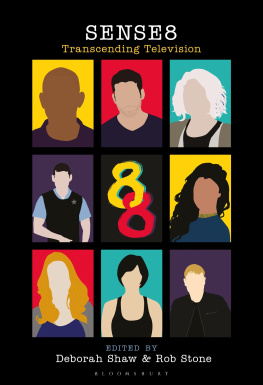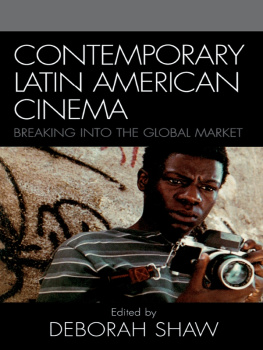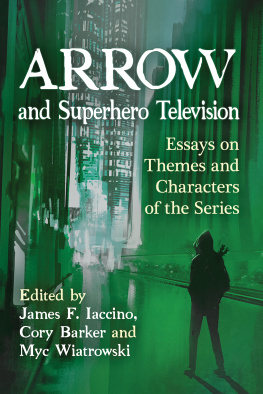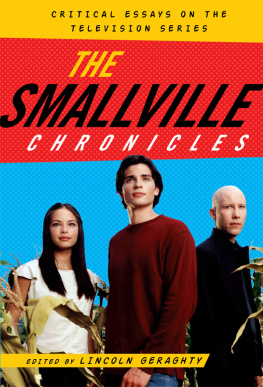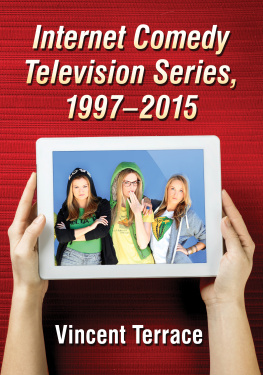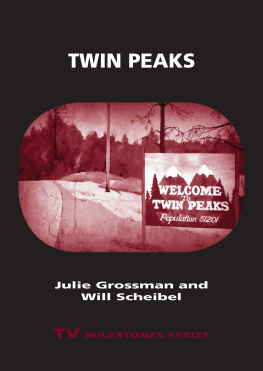
Sense8
Sense8
Transcending Television
Edited by
Deborah Shaw and Rob Stone

BLOOMSBURY ACADEMIC
Bloomsbury Publishing Inc
1385 Broadway, New York, NY 10018, USA
50 Bedford Square, London, WC1B 3DP, UK
29 Earlsfort Terrace, Dublin 2, Ireland
BLOOMSBURY, BLOOMSBURY ACADEMIC and the Diana logo are trademarks of Bloomsbury Publishing Plc
First published in the United States of America 2021
Volume Editors Part of the Work Deborah Shaw and Rob Stone, 2021
Each chapter of Contributors
For legal purposes the constitute an extension of this copyright page.
Cover design: Namkwan Cho
Cover image Isadora Casavechia
All rights reserved. No part of this publication may be reproduced or transmitted in any form or by any means, electronic or mechanical, including photocopying, recording, or any information storage or retrieval system, without prior permission in writing from the publishers.
Bloomsbury Publishing Inc does not have any control over, or responsibility for, any third-party websites referred to or in this book. All internet addresses given in this book were correct at the time of going to press. The author and publisher regret any inconvenience caused if addresses have changed or sites have ceased to exist, but can accept no responsibility for any such changes.
Library of Congress Cataloging-in-Publication Data
Names: Shaw, Deborah, editor. | Stone, Rob, 1965 editor.
Title: Sense8 : transcending television / edited by Deborah Shaw and Rob Stone. Other titles: Sensate
Description: New York : Bloomsbury Academic, 2021. |
Includes bibliographical references and index.
Identifiers: LCCN 2021000981 (print) | LCCN 2021000982 (ebook) |
ISBN 9781501352935 (hardback) | ISBN 9781501352928 (ebook) |
ISBN 9781501352911 (pdf)
Subjects: LCSH: Sense8 (Television program)
Classification: LCC PN1992.77.S42977 S46 2021 (print) |
LCC PN1992.77.S42977 (ebook) | DDC 791.45/72dc23
LC record available at https://lccn.loc.gov/2021000981
LC ebook record available at https://lccn.loc.gov/2021000982
ISBN: HB: 978-1-5013-5293-5
ePDF: 978-1-5013-5291-1
eBook: 978-1-5013-5292-8
To find out more about our authors and books visit www.bloomsbury.com and sign up for our newsletters.
CONTENTS
Deborah Shaw and Rob Stone
Amanda D. Lotz
Zo Shacklock
James Walters
Deborah Shaw
Rosalind Galt
John Lessard
Rob Stone
Luis Freijo
Will McKeown
So Mayer
Rox Samer and Laura Horak
Cel M. Keegan
We would very much like to thank Katie Gallof and Erin Duffy at Bloomsbury for their support and guidance throughout the production of Sense8: Transcending Television. Thanks to them and our amazing cluster of contributors, this book also transcended the pandemic. We are especially grateful to Isadora Casavechia for her captivating cover image and to Esther Santamara Iglesias for her superb work compiling the index.
Deborah would like to dedicate this book to her amazing academic friends and contributors to this collection who chose to merge their fandom for Sense8 with their research. She would like to thank Rob Stone who made this a labor of love. She gives thanks to the Faculty of CCI at the University of Portsmouth for its support, and to her colleagues and students in the School of Film, Media and Communication. She would like to use this space to send her love to Lesley and Godfrey, Mitch, Theo, and the furry housemates.
Rob would like to thank Deborah for being the most brilliant and lovely clustermate throughout this venture, as well as our fellow sensates who contributed so enthusiastically to this project. He thanks Andy Henderson for his notes on world music and his colleagues in the Department of Film and Creative Writing at the University of Birmingham and the research students that make B-Film: The Birmingham Centre for Film Studies into such a wonderful cluster. He sends his love to the woman in his head Esther, as always.
We would like to thank the University of Illinois Press for permission to partially reprint (with significant edits and revisions) Cel M. Keegans EpilogueEvent Horizon: Sense8 from Lana and Lilly Wachowski: Sensing Transgender. Copyright 2018 by the Board of Trustees of the University of Illinois. Used with permission of the University of Illinois Press.
Deborah Shaw and Rob Stone
Making sense of Sense8 requires a certain sensibility. Dreamt up by Lana and Lilly Wachowski and J. Michael Straczynski for Netflix, Sense8 dropped onto the global streaming platform on June 5, 2015, with the first episode S01:E01 Limbic Resonance introducing a multinational ensemble cast playing eight strangers from different parts of the world. And, as viewers discovered that these characters shared mental, physical, and emotional experiences that amounted to radical empathy, so they claimed to share them too, not only via their viewing of the series but also through an online fan base that would grow to determine the fate of the series. Ostensibly science fiction, relating how these eight sensates realize they are a separately evolved species that can communicate telepathically, body-swap in times of need, and transcend time and space to form a resistance group that fights for survival against a sinister organization called the Biological Preservation Organization (BPO), Sense8 quickly transcended its synopsis.
Proud and loud, delirious with the possibilities of pushing aside television tropes, categories, and restrictions, Sense8 was astonishingly queer and primed to party with big themes of religion, politics, identity, gender, and sexuality as well as to contend with addiction, corruption, racism, homophobia, transphobia, surveillance, and Big Pharma. Utopian in outlook though occurring in a recognizably dystopian world, Sense8 used its science fiction premise to explore new forms of being and becoming that referred to and enacted social, philosophical, virtual, queer and trans potentialities. Netflix did not promote Sense8 through traditional means but via algorithm-driven targeting to existing subscribers but, as there was little to compare it with, its science fiction label shortchanged some genre fans and its queer credentials deterred others. Nevertheless, Sense8 garnered a devoted audience and praise for bending genre and gender, along with Emmy nominations for its music in 2016 and its cinematography in 2017, the 2016 Location Managers Guild International Award for outstanding achievement, and the 2016 GLAAD Media Award for Outstanding Drama Series in recognition of its representation of LGBTQ characters and themes.
Although never a mainstream hit that might have justified its production costs and ensured more than two awkwardly shaped seasons, Sense8 was a wayward flagship for Netflix that still transcended televisions categories of genres, regularized formats and character types, and united, inspired, and energized a global audience that discovered it had the power to similarly transcend the traditionally more passive and receptive nature of their spectatorship. Most remarkably, therefore, it is the commissioning, cult success, cancellation, and resurrection of the series that demand new frameworks for understanding the dynamics of streaming content as well as the fresh activism and resulting emancipation of an audience that is online, not just for viewing purposes but for interacting with its makers and other spectators via social media too. New viewing practices such as the single-sit series, the repetitive binge-watch, and simultaneous communal tweeting and watch parties have given rise to responsive audience-led forms of auteurism that incorporate the fan base, which duly develops its own agency to the point when it can successfully campaign for a continuation or new ending to a cherished series. Indeed, the online activity of Sense8 s global network of fans mirrors in a progressive and meaningful manner the interconnectivity of the series protagonists.
Next page
